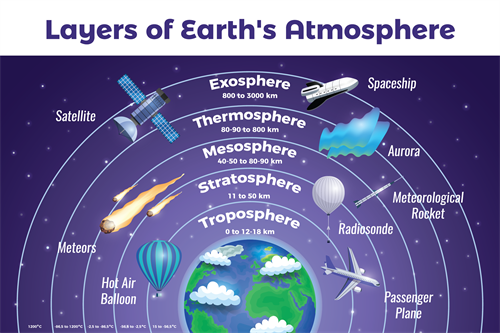
PUMPA - SMART LEARNING
எங்கள் ஆசிரியர்களுடன் 1-ஆன்-1 ஆலோசனை நேரத்தைப் பெறுங்கள். டாப்பர் ஆவதற்கு நாங்கள் பயிற்சி அளிப்போம்
Book Free DemoThe five atmospheric layers are:
- Troposphere
- Stratosphere
- Mesosphere
- Thermosphere and
- Exosphere
Troposphere
Stratosphere
This is the second layer of the atmosphere. It extends from the tropopause to about 50 km above the Earth surface. Here, temperature increases with an increase in height, due to the absorption of the ultraviolet radiation of the Sun by ozone present in this layer. With the concentration of ozone molecules, it is also referred to as the ozonosphere. Large jet planes normally fly here. The upper limit of the stratosphere is called as stratopause.
Mesosphere
Above the stratosphere lies the mesosphere. The mesosphere extends between 50km and 80km. Here, the temperature decreases with increasing height, falling as low as \(-90 °C\). Radio waves transmitted from Earth are reflected back to Earth from this layer. Most of the meteors nearing Earth's horizon get burned here. The uppermost limit of the mesosphere is mesopause.

Thermosphere
The thermosphere lies above the mesosphere. This layer extends to a height of about \(600\ \)km. In this layer, the temperature rises dramatically, reaching up to \(1480 °C\). The rise in temperature is mainly due to the fact that the gas molecules in this layer absorb the X-rays and ultraviolet radiation of the Sun. This results in the break up of the gas molecules into positively and negatively charged particles or ions. This layer of thermosphere that contains Ions and free electrons is called as Ionosphere.
Having more or less the same composition of gases lower thermosphere is also called "Homosphere". Whereas the upper portion of the thermosphere having an uneven composition of gases is referred to as the “Heterosphere”. Here the temperature increases with increasing height.
Exosphere
The uppermost layer of the atmosphere is called the exosphere. It extends beyond the thermosphere up to \(960\ \)\(km\). This layer is extremely rarefied with gases and gradually merges with the interplanetary space. This zone is characterized by aurora Australis and aurora borealis.
The Magnetosphere, which lies beyond the exosphere, is the Earth's magnetic belt, where protons and electrons coming out from the Sun are trapped. The magnetic field of Earth extends to around \(64,000\ \)km above the Earth.
Near the North or South Pole, one can enjoy ecstatic cosmic shows in the sky called auroras. Near the North pole, it is called aurora borealis or northern lights. In the South pole, it is called aurora australis or the southern lights.